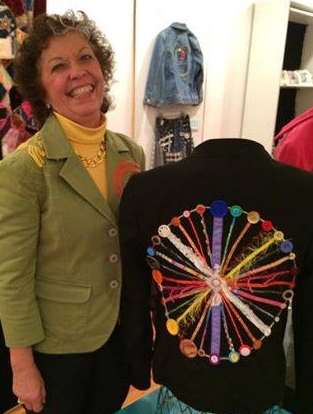| Sharon Barnes Sharon was first diagnosed with chronic fatigue and immune deficiency syndrome in the spring of 1993. Early in ’99, fibromyalgia joined CFIDS and together, they took center stage in her life for several years. Her recovery had accumulated sufficient momentum by 2007 for her to return to work full time. In this story, she shares lessons she learned deep in the throes of illness. |
I was ready to implode from the pain
“What’s wrong with you? I’m worried about you. All you do is sleep. Are you depressed?” My husband Gary shook me awake with these encouraging words one Sunday afternoon in the spring of 1999. The searing bone pain had finally lessened enough that I could relax and sleep, but now he was waking me up. “I’m not depressed,” I told him. “I hurt so much I hardly slept at all last night and just now got to sleep. Leave me alone and LET ME SLEEP!”
It had been months since I had had a decent night’s sleep and years since I had normal energy. Every move felt like I 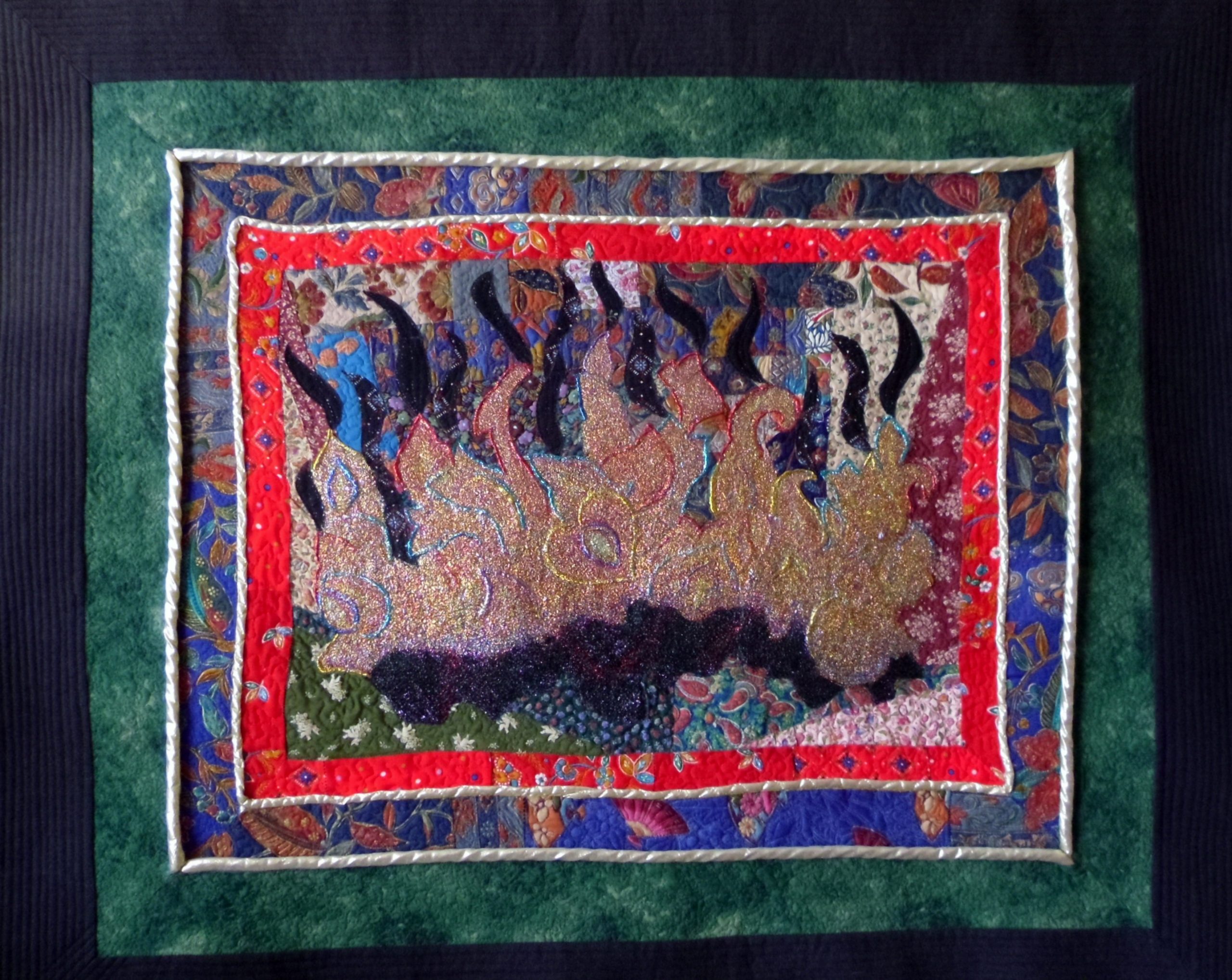 was dragging an elephant behind me. My bones seemed to be on fire. Every touch felt like it would burn right through me. Every sound grated on my spine. At times, I couldn’t walk even a block or climb the stairs at home without crawling up them. My brain was often in a thick pea soup fog like Winnie the Pooh sitting on the log telling himself to “think, think, think” except that my neurotransmitters weren’t connecting.
was dragging an elephant behind me. My bones seemed to be on fire. Every touch felt like it would burn right through me. Every sound grated on my spine. At times, I couldn’t walk even a block or climb the stairs at home without crawling up them. My brain was often in a thick pea soup fog like Winnie the Pooh sitting on the log telling himself to “think, think, think” except that my neurotransmitters weren’t connecting.
One day when I felt like I was going to implode from the physical and emotional pain, I went into my sewing room, desperate for relief. I remembered how I used to teach others how to use their creativity to heal emotionally. Maybe there was something I could do to help myself. I scrounged around for the ugliest, most awful fabrics I could find. Yes! One of my aunts had recently died, and I had inherited some of her fabric. I found some atrocious scraps, just like my life. Then I saw some that I liked. Hmm. My life had not always been this rotten. Maybe I could start with some good stuff and stitch the horrid fabric around it. I couldn’t cut or stitch straight lines. No matter. My life had no straight lines, either. This piece looked quite primitive, matching my life again. But what about the brain fog? I found a layer of ugly foggy looking fabric and covered over some of the other fabric.
The worse it looked, the better I felt
 The process of making ugliness and dreariness surround and eclipse beauty in the fabric just like it did in my life seemed
The process of making ugliness and dreariness surround and eclipse beauty in the fabric just like it did in my life seemed
to pull pain, fatigue and even brain fog out of me like a vacuum cleaner. I was amazed, stunned. Shivers ran up and down my back as I grasped what had happened. Before I had gotten sick, I had used tools like this in my counseling work. I remembered when I had worked alongside my clients as I facilitated “The Quilter’s Journey,” a counseling group in which we did various kinds of creative handwork while we talked. We had experienced and appreciated many emotional and psychological benefits from making things with our hands. But physical benefits? Perhaps I had only glimpsed the edges of the healing power of creative expression.
Meditating the physical and emotional pain out of me
In between times of working/playing with “Foggy Days and Groggy Nights” (Fig. 1), I would pin the piece on my 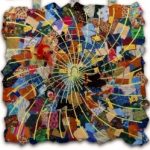 design wall (a ½ inch sheet of foam insulation covered with felt). When I was not functional enough to sew, I could at least sit or even lie on the floor and look at it. I found that meditating on it also facilitated the flow of physical and emotional pain through and out of me. It nourished my soul. It instructed me. As I listened with my inner ear, I heard words of wisdom. It inspired me in my search for healing. My creative handwork evolved into “contemplative handwork;” an interlocking, interwoven process that facilitated and guided my emotional healing as I also sought physical healing.
design wall (a ½ inch sheet of foam insulation covered with felt). When I was not functional enough to sew, I could at least sit or even lie on the floor and look at it. I found that meditating on it also facilitated the flow of physical and emotional pain through and out of me. It nourished my soul. It instructed me. As I listened with my inner ear, I heard words of wisdom. It inspired me in my search for healing. My creative handwork evolved into “contemplative handwork;” an interlocking, interwoven process that facilitated and guided my emotional healing as I also sought physical healing.
Creative and contemplative handwork can be a deep creative, spiritual, emotional and psychological practice. The process of making something which demonstrates our inner state and represents our inner thought process reaches deep within us, taps into and brings out emotion and experience that cannot be found or expressed otherwise.
A conduit for releasing stagnating energy
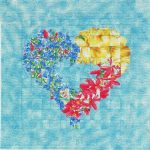 If a picture is worth a thousand words, a picture that the Self creates for it own healing can be worth a hundred thousand words. We create something for which we have no words; we express experience and emotion for which we have no explanation. As we contemplate what we have made, words then emerge from the depths of soul. In this way, creative and contemplative handwork become a conduit for energy that otherwise gets blocked and stagnates inside of us. When it stagnates, our bodies become a container for the energy and emotion that had stopped flowing. When we have overwhelming life experiences and shut down both emotionally and physically, the emotions and the biochemicals generated from these emotions can get blocked from exiting the body. They pool like an eddy in a river, going ’round and ’round, building up foam, froth and filth or just growing algae. Our bodies become the container for all of this unless or until we find a way to open up the flow.
If a picture is worth a thousand words, a picture that the Self creates for it own healing can be worth a hundred thousand words. We create something for which we have no words; we express experience and emotion for which we have no explanation. As we contemplate what we have made, words then emerge from the depths of soul. In this way, creative and contemplative handwork become a conduit for energy that otherwise gets blocked and stagnates inside of us. When it stagnates, our bodies become a container for the energy and emotion that had stopped flowing. When we have overwhelming life experiences and shut down both emotionally and physically, the emotions and the biochemicals generated from these emotions can get blocked from exiting the body. They pool like an eddy in a river, going ’round and ’round, building up foam, froth and filth or just growing algae. Our bodies become the container for all of this unless or until we find a way to open up the flow.
Our hands know something our frontal lobes do not
Repetitious handwork facilitates shifting into alpha brain waves, the flow of deep relaxation, creativity, and peak 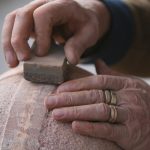 performance. Creative and contemplative handwork gently breaks loose what has gotten stuck inside. It reaches deep within, latching onto the blocked emotion and energy like a magnet, sliding it softly, almost imperceptibly out of us; healing what hurts and freeing up energy and creativity once more. Our hands have wisdom and skill in facilitating this process that our frontal lobes know nothing of. We cannot plan this out in a linear, sequential fashion. We have to allow some other part of ourselves to guide and enable this process.
performance. Creative and contemplative handwork gently breaks loose what has gotten stuck inside. It reaches deep within, latching onto the blocked emotion and energy like a magnet, sliding it softly, almost imperceptibly out of us; healing what hurts and freeing up energy and creativity once more. Our hands have wisdom and skill in facilitating this process that our frontal lobes know nothing of. We cannot plan this out in a linear, sequential fashion. We have to allow some other part of ourselves to guide and enable this process.
I was nine years old when I learned to sew. My first dress was red with large white polka dots. I loved the act of dress-making and then wearing what I had made with my own hands. My best memories with my mother came while we sewed together. She was a great teacher-so I knew more about sewing and sewed better than my high school Home-Ec teachers. I made most of my clothes for many years—until I graduated from college, got married and started working. How do you fit an impractical hobby such as sewing into a full life? I had no idea. I sewed a few things, took a stained glass class which enabled me to make a stained glass eagle for my husband Gary, lined a large basket and made a fabric lid for it. But that was the extent of my creative expression for many years.
From doll-making to quilting
One day in the late 1980’s, my sister-in-law Donna came to me wearing a sheepish grin and holding a small white plastic Levi’s shopping bag in front of her. “I was going to make a quilt for you using this stuff, but after all these years, I know that if anyone is going to make a quilt from them, it will be you, since you sew and I don’t.” She took a stack of twenty-some quilt blocks out of the bag, each one made in 1974 by a friend, or one of my or my husband’s family. She had recruited all these people to make blocks for a quilt for me for my wedding! I was thrilled and speechless. Yes, I sewed. But make a quilt? I had no idea how to make a quilt and creative expression was no longer even on my priority list, let alone any list. So the quilt blocks made for my wedding quilt sat hidden, stored away for years in their Levi’s bag, just waiting.
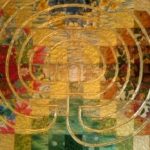 Rediscovering their presence created an opening for creativity in my life. Suddenly I was thinking about the quilt and looking for opportunities. When I read Clarissa Pinkola Estes’ account of her clients making things with their hands that represented and facilitated their inner work in her book Women Who Run With The Wolves, it struck a familiar chord in me. I soon began looking for a way to incorporate creative handwork in my counseling work with clients.
Rediscovering their presence created an opening for creativity in my life. Suddenly I was thinking about the quilt and looking for opportunities. When I read Clarissa Pinkola Estes’ account of her clients making things with their hands that represented and facilitated their inner work in her book Women Who Run With The Wolves, it struck a familiar chord in me. I soon began looking for a way to incorporate creative handwork in my counseling work with clients.
One day I attended a professional meeting featuring a presentation on Journey of the Doll, a class taught by Lesli Verdi, LCSW. I knew instantly that this was what I was looking for. For ten months, I made a variety of craft items, including a life-size doll, listened to stories, participated in a group process and learned how to include creative expression in both my personal life and therapeutic work.
As I completed the Journey of the Doll, I decided to facilitate a counseling group similar to this, but rather than doll 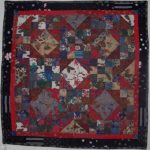 making, we would use quilting as the primary media. I put the word out and a few women signed up for it. But I didn’t know how to quilt. When I found a class, I thought I’d finally complete the wedding quilt that had been waiting to be made for so many years. But no, it didn’t meet the criteria for the class project. We were given a choice of one of four patterns to use. It seemed fitting that I chose the Hourglass quilt pattern for this quilt that was so timely. For fabric, I used a stack of fabric samples from the 1970’s, ones that my mother had reclaimed from a thrift store many years ago. Everything in the quilt, including the borders and backing, were made from these scraps. It also seemed fitting to use scraps to make a quilt that taught me the basic quilting skills I needed so I could help others transform the scraps of their lives into something beautiful and beneficial.
making, we would use quilting as the primary media. I put the word out and a few women signed up for it. But I didn’t know how to quilt. When I found a class, I thought I’d finally complete the wedding quilt that had been waiting to be made for so many years. But no, it didn’t meet the criteria for the class project. We were given a choice of one of four patterns to use. It seemed fitting that I chose the Hourglass quilt pattern for this quilt that was so timely. For fabric, I used a stack of fabric samples from the 1970’s, ones that my mother had reclaimed from a thrift store many years ago. Everything in the quilt, including the borders and backing, were made from these scraps. It also seemed fitting to use scraps to make a quilt that taught me the basic quilting skills I needed so I could help others transform the scraps of their lives into something beautiful and beneficial.
We often teach what we most need to know
It has also been said that we can only teach what we most need to know. Little did I know that I was soon going to need this knowledge and these tools to transform the scraps of my own life. When we’re in the midst of trouble and adversity–loss, illness or tragedy—these circumstances can be a catalyst for great good in our lives-what an absurd idea. Yet it’s a widely held idea. One of Napoleon Hill’s most famous saying is “In every adversity is the seed of equal or greater benefit.” Saint Paul said, “We know that God will make everything that happens to us come out to our eventual good, as long as we trust Him and remain true to the purpose for which He called us.”
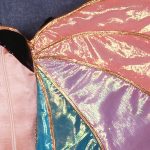 But how do we access this seed of greater benefit? How do we hang in there until the “eventual good” comes? And then, how do we tap into it? With creative and contemplative handwork, I stumbled upon a tool that can provides both a pathway and the means to transform life’s scraps into something that’s not only beneficial, but sometimes even beautiful. The visual, tangible transformation is symbolic of, and assists with, the unseen transformation that occurs deep within us as we work simultaneously with our hands and our hearts.
But how do we access this seed of greater benefit? How do we hang in there until the “eventual good” comes? And then, how do we tap into it? With creative and contemplative handwork, I stumbled upon a tool that can provides both a pathway and the means to transform life’s scraps into something that’s not only beneficial, but sometimes even beautiful. The visual, tangible transformation is symbolic of, and assists with, the unseen transformation that occurs deep within us as we work simultaneously with our hands and our hearts.

